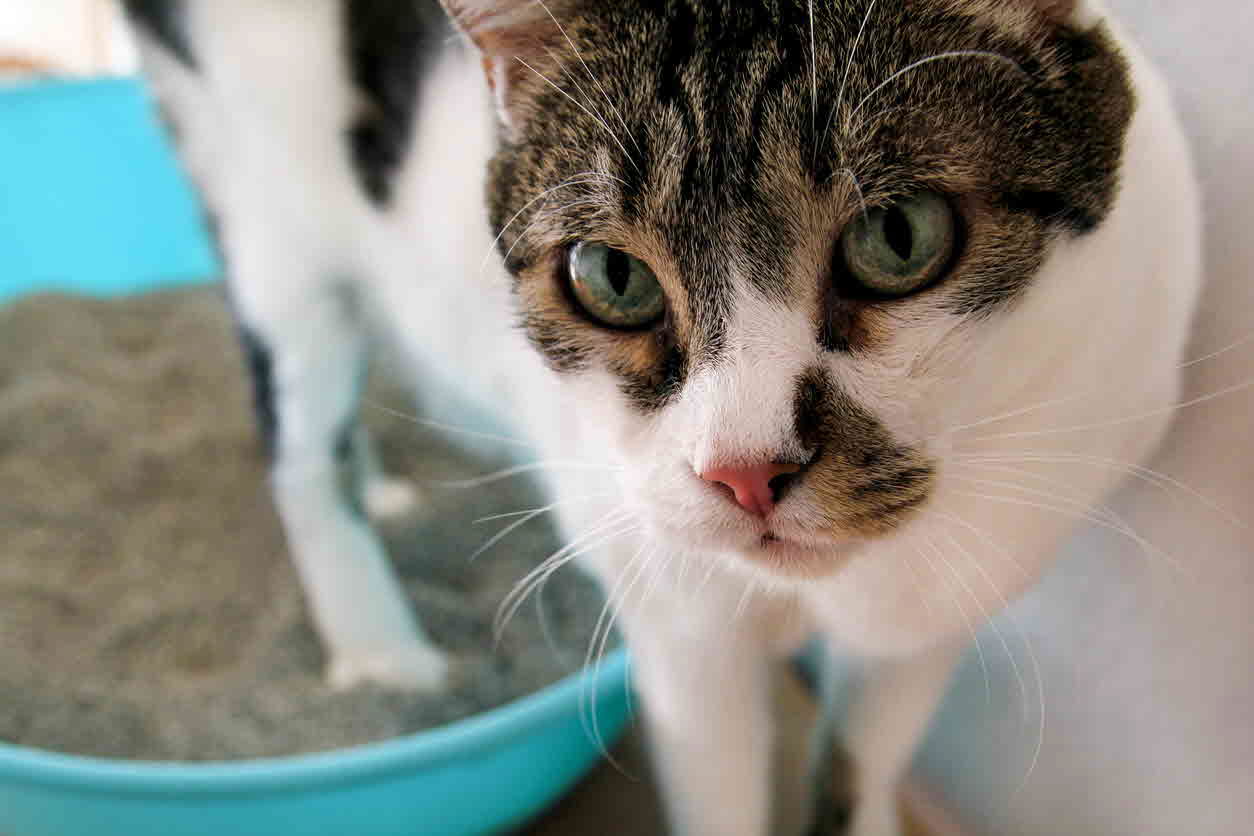Cats and toileting

Going to the toilet is very natural, but for your cat there’s more to it than you might think. Cat’s urine and faeces carry information that is important for communication with other cats, and cats think we understand this information too!
When your cat rubs its cheek against your leg, it is smearing you with pheromones. These natural chemicals messengers transmit information to other cats. Urine and faeces also contain pheromones which transmit information about the cat, its health and its home territory. Saying “I was here” increases your cat’s personal security, is calming and sends information to any visiting cats or other feline residents.
Common litter tray problems and what they mean
Marking or spraying
This is a cat’s way of communicating and involves depositing small volumes of urine on vertical objects of importance to the cat, such as doors, curtains or walls. The cat will back up to the area, may tread up and down with its back legs and its tail may quiver. Often they advertise like a billboard – the more traffic the better!
It is most common in male cats that haven’t been desexed. Desexing will reduce the behaviour by up to 90%.
Anything that makes a cat anxious about its territory may also lead to spaying, including other cats in the house, neighbouring cats entering the backyard, visitors and changes in your routine.
Going to the toilet outside the litter tray
This is usually caused by a problem with the litter tray itself such as the type of tray, the type of litter, its location and cleanliness of the tray.
This cat often deposits large amounts of urine or faeces outside the litter tray and adopts a normal squatting position while doing so.
Showing signs of stress while going to the toilet
This is more unusual and usually means that your cat has a medical problem that needs attention. Signs of toilet stress include panting, excessive scratching of litter before or after going to the litter tray and passing unusual looking urine or faeces.
Solutions
Rule out medical illness
- Cats that need to go to the toilet more frequently or show pain when toileting may be suffering from a variety of medical problems such as urinary tract infections, food intolerance, intestinal worms, constipation or diabetes.
- It is always best to get a general health check for your cat including a urine examination from your regular veterinarian. If your cat is straining and not passing anything, this needs urgent attention.
Make the toilet more attractive
- Give your cat a choice of litter types to work out which one it prefers. Sand-like, finely granular, clumping and non-perfumed litter is usually the most preferred.
- Cats are clean creatures. Scoop litter daily and wash and completely replenish the tray weekly. Do not use bleaches or disinfectants to clean the litter tray as they may smell too strong for the cat.
- Test different types of trays and make sure it’s big enough and the sides are low enough for your cat to easily get in and out of - a rule of thumb is a litter tray that is one-and-a-half times the length of your cat.
- Consider increasing the litter depth. Studies suggest 3cm is a good minimum depth to use.
- Access and location are important. If you have more than one cat, you need one tray per cat plus one extra in different locations (that is not side by side). They also like their privacy locate the tray in a quiet area of the house.
Clean the area where they have eliminated where they shouldn’t
- Cats 'top up' areas where they have eliminated when they detect the odour is fading. If they can’t tell where they’ve been, they’re less likely to go back!
- Clean the entire area thoroughly with non-ammonia based cleaner like washing powder or detergent, dry it well and apply an enzymatic, biodegradable odour neutraliser.
Change the nature of the location
- Placing a bowl of food, or a pot plant in the area, or placing bubble wrap or foil on the floor where they’ve eliminated can make the area take on a different meaning.
Re-train them to use the tray
- Some cats may have had a bad experience in the tray, such as being caught to be medicated, scared by a dog or experiencing pain due to a bladder infection, and as a result, developed a fear of the tray. These cats need to re-learn that the tray was not the cause of pain or fear.
- Sometimes keeping them in an isolated room with the tray, bed, food, water, toys, and regular visitors for cuddles and games can help them reacquaint themselves with the tray.
Reduce anxiety and stress
- Identify triggers of stress such as multiple cats, neighbourhood cats, new visitors or pets, moving house or new furniture.
- A veterinary behaviourist is the best person to help you identify possible triggers, methods of behaviour modification to use and to advise if anti-anxiety medication is required, and if so, which is best. A synthetic pheromone based on the facial pheromone cats use to familiarise themselves and feel calm in their territory, can also be very helpful. Ask your veterinarian.
- Reduce stress by establishing routines for play and feeding.
Know who the culprit is!
- This is very important if you have more than one cat!
- Don’t presume it’s the 'scaredy-cat' in the house. Cats are masters of subtle body language. You may need an overnight video on the area, or a veterinary behaviourist can give advice on how to identify the one responsible.
